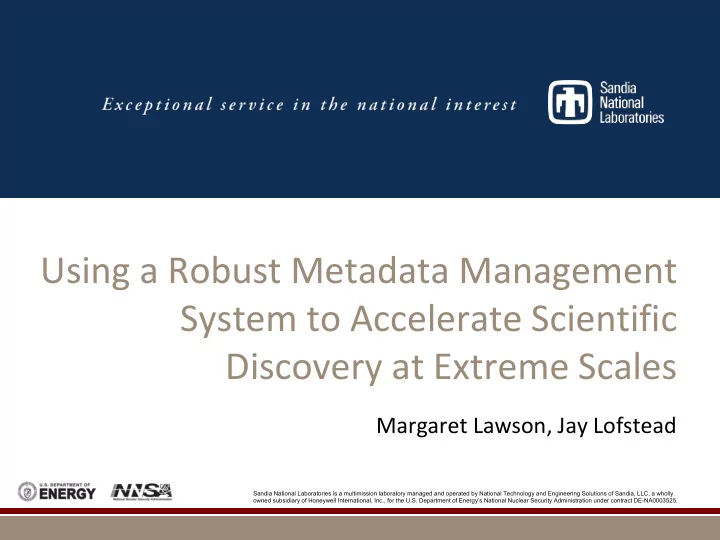

Using a Robust Metadata Management System to Accelerate Scientific Discovery at Extreme Scales Margaret Lawson, Jay Lofstead Sandia National Laboratories is a multimission laboratory managed and operated by National Technology and Engineering Solutions of Sandia, LLC, a wholly owned subsidiary of Honeywell International, Inc., for the U.S. Department of Energy’s National Nuclear Security Administration under contract DE-NA0003525.
Problems Faced § A single output can produce a dataset in the terabyte to petabyte range § Large datasets are very slow to move and search § Scientists have limited allocations of computational resources 2
Custom Metadata Solution 3
Previous Work - EMPRESS 1.0 § Proof of concept § Rich, custom metadata management can be supported with reasonable efficiency and scalability § Next steps § Improving the efficiency, scalability, and functionality to create a viable production system 4
Paper Contributions § EMPRESS 2.0 § Queries § Atomic operations § Fault tolerance § Portability § RDBMS is a viable HPC technology for data-oriented metadata 5
Metadata Model 6
Custom Metadata Queries § Supports a wide variety of queries including global, spatial, temporal and multivariate § E.g., list all runs or timesteps that contain a “blob” near the reactor edge 7
Atomic Operations § Low overhead transactions § Transactions are atomic (committed in their entirety or aborted) § Metadata is given a transaction id that determines its external visibility § Eliminates the need for locks or blocking of service § The implementation is largely based on the D 2 T system [1] 8
Fault Tolerance § Users can choose how to recover from failures occurring at the function, transaction, and hardware levels § Basic metadata may be redundant, preventing data loss § E.g., if used with an I/O system 9
Portability § Directly storing the names of associated data objects limits portability and scalability § EMPRESS 2.0 does not store the names, it uses a function to generate them § All EMPRESS metadata is portable 10
Implementation 11
Evaluation - Experiment Types 12
Evaluation – Write Process § Run structure: § One application run, three timesteps, ten 3-D variables § Data § Each process writes 0.4GB of data (10% of RAM) per timestep § Custom metadata: § 10 different tags of varying frequency § On average, each process writes 26 attributes per timestep (2.6 per variable) 13
Evaluation – Read Process 1. 6 common read patterns [2] are performed including 1. An entire variable 2. A plane and partial plane in each dimension 3. A 3-D subspace 2. Custom metadata is used to identify potential features of interest and the associated data is read in 14
Evaluation – Writing § Both can do efficient metadata writes at the evaluated scales § But EMPRESS can scale out to achieve constant performance 15
Evaluation – Metadata Read § HDF5 takes almost as long to do the metadata query as it does to read the data 16
Evaluation – Accelerating Data Reads § EMPRESS can significantly accelerate data reads by limiting the scope to data of interest 17
Future Work - EMPRESS § Evaluation § Potential bottlenecks & solutions § Comparison to more alternatives § NoSQL vs RDBMS § Functionality § Expanding the application classes that EMPRESS can support 18
Conclusions § Custom metadata is an important tool for accelerating post-processing § Current I/O tools cannot efficiently support custom metadata services § EMPRESS 2.0 offers insights on the functionalities needed for a production system & how to implement them scalably 19
Acknowledgements § Sandia National Laboratories is a multimission laboratory managed and operated by National Technology and Engineering Solutions of Sandia, LLC, a wholly owned subsidiary of Honeywell International, Inc., for the U.S. Department of Energy’s National Nuclear Security Administration under contract DE-NA0003525. § This work was supported under the U.S. Department of Energy National Nuclear Security Agency ATDM project funding. This work was also supported by the U.S. Department of Energy Office of Science, under the SSIO grant series, SIRIUS project and the Data Management grant series, Decaf project, program manager Lucy Nowell. 20
Citations § [1] J. Lofstead, J. Dayal, K. Schwan, and R. Oldfield, “D2t: Doubly dis- tributed transactions for high performance and distributed computing,” in Cluster Computing (CLUSTER), 2012 IEEE International Conference on . IEEE, 2012, pp. 90–98. § [2] J. Lofstead, M. Polte, G. Gibson, S. Klasky, K. Schwan, R. Oldfield, M. Wolf, and Q. Liu, “Six degrees of scientific data: reading patterns for extreme scale science IO,” in Proceedings of the 20th international symposium on High performance distributed computing , ser. HPDC ’11. ACM, 2011, pp. 49–60. [Online]. Available: http://doi.acm.org/10.1145/1996130.1996139 21
Recommend
More recommend